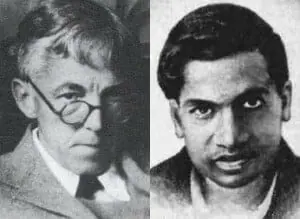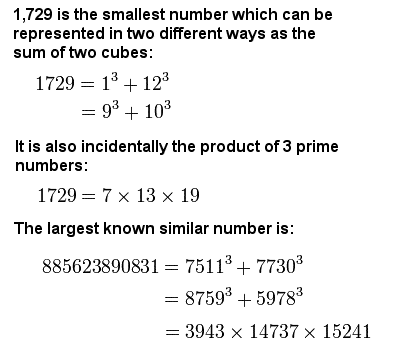GODFREY HAROLD: RAMANUJAN’S MENTOR
Biography
 |
G.H. Hardy (1877-1947) and Srinivasa Ramanujan (1887-1920) |
The eccentric British mathematician G.H. Hardy is known for his achievements in number theory and mathematical analysis. But he is perhaps even better known for his adoption and mentoring of the self-taught Indian mathematical genius, Srinivasa Ramanujan.
Hardy himself was a prodigy from a young age, and stories are told about how he would write numbers up to millions at just two years of age, and how he would amuse himself in church by factorizing the hymn numbers. He graduated with honours from Cambridge University, where he was to spend most of the rest of his academic career.
Hardy is sometimes credited with reforming British mathematics in the early 20th Century by bringing a Continental rigour to it, more characteristic of the French, Swiss and German mathematics he so much admired, rather than British mathematics. He introduced into Britain a new tradition of pure mathematics (as opposed to the traditional British forte of applied mathematics in the shadow of Newton), and he proudly declared that nothing he had ever done had any commercial or military usefulness (he was also an outspoken pacifist).
Just before the First World War, Hardy (who was given to flamboyant gestures) made mathematical headlines when he claimed to have proved the Riemann Hypothesis. In fact, he was able to prove that there were infinitely many zeroes on the critical line, but was not able to prove that there did not exist other zeroes that were NOT on the line (or even infinitely many off the line, given the nature of infinity).
Meanwhile, in 1913, Srinivasa Ramanujan, a 23-year old shipping clerk from Madras, India, wrote to Hardy (and other academics at Cambridge), claiming, among other things, to have devised a formula that calculated the number of primes up to a hundred million with generally no error. The self-taught and obsessive Ramanujan had managed to prove all of Riemann’s results and more with almost no knowledge of developments in the Western world and no formal tuition. He claimed that most of his ideas came to him in dreams.
Hardy was only one to recognize Ramanujan’s genius, and brought him to Cambridge University, and was his friend and mentor for many years. The two collaborated on many mathematical problems, although the Riemann Hypothesis continued to defy even their joint efforts.
Taxicab Numbers
 |
Hardy-Ramanujan “taxicab numbers” |
A common anecdote about Ramanujan during this time relates how Hardy arrived at Ramanujan’s house in a cab numbered 1729, a number he claimed to be totally uninteresting. Ramanujan is said to have stated on the spot that, on the contrary, it was actually a very interesting number mathematically, being the smallest number representable in two different ways as a sum of two cubes. Such numbers are now sometimes referred to as “taxicab numbers“.
It is estimated that Ramanujan conjectured or proved over 3,000 theorems, identities and equations, including properties of highly composite numbers, the partition function and its asymptotics and mock theta functions. He also carried out major investigations in the areas of gamma functions, modular forms, divergent series, hypergeometric series and prime number theory.
Among his other achievements, Ramanujan identified several efficient and rapidly converging infinite series for the calculation of the value of π, some of which could compute 8 additional decimal places of π with each term in the series. These series (and variations on them) have become the basis for the fastest algorithms used by modern computers to compute π to ever increasing levels of accuracy (currently to about 5 trillion decimal places).
Eventually, though, the frustrated Ramanujan spiralled into depression and illness, even attempting suicide at one time. After a period in a sanatorium and a brief return to his family in India, he died in 1920 at the tragically young age of 32. Some of his original and highly unconventional results, such as the Ramanujan prime and the Ramanujan theta function, have inspired vast amounts of further research and have found applications in fields as diverse as crystallography and string theory.
Hardy lived on for some 27 years after Ramanujan’s death, to the ripe old age of 70. When asked in an interview what his greatest contribution to mathematics was, Hardy unhesitatingly replied that it was the discovery of Ramanujan, and even called their collaboration “the one romantic incident in my life“. However, Hardy too became depressed later in life and attempted suicide by an overdose at one point. Some have blamed the Riemann Hypothesis for Ramanujan and Hardy’s instabilities, giving it something of the reputation of a curse.
<< Back to 20th Century Mathematics | Forward to Russell and Whitehead >> |
